Let’s talk about PEX, baby!
While it will help if you’re mechanically inclined, you don’t need to be a journeyman plumber to read this guide. I just want to answer some basic questions, like:
- Whether RV PEX is the same as household PEX?
- What size of PEX is used in an RV?
- How do you repair PEX in an RV? (click for a how-to run-down!)
If you renovate campers or do your own repair work, you’ll find this guide extra-helpful! In particular, knowing how PEX works can make a water pump replacement much, much easier.
Alright, let’s get the waters flowin’.
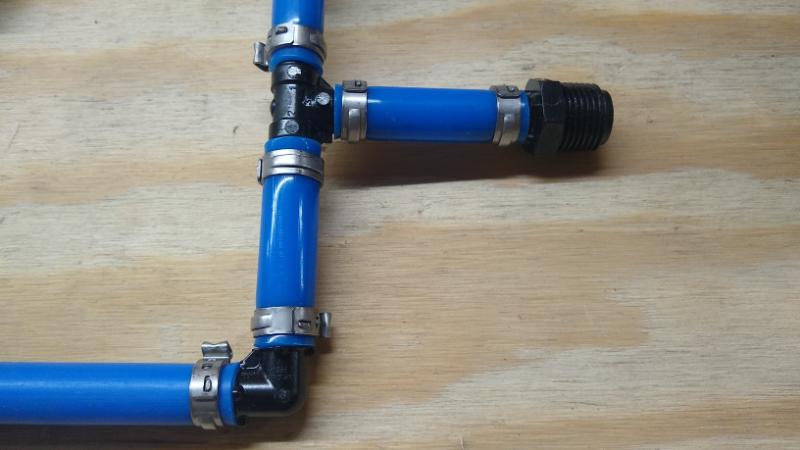
PEX in the Great Circle of Life
Let’s paint a picture of where PEX is used inside your RV.
Your RV freshwater system has many components:
- Water tank
- Pump and check valve
- Gravity/city water inlet
- Piping and tubing
- Faucets and diverters
- Filters, strainers and regulators
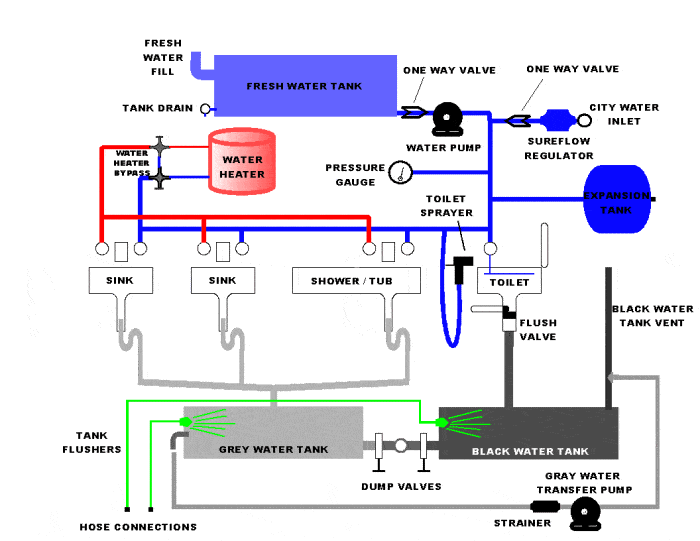
As you can see, it can be quite complicated!
Let’s crop this mental image and ignore everything except the pipe between your on-demand water pump and your faucets and diverters. In other words, let’s focus just on the fresh water distribution system.
The water distribution plumbing has four parts:
- Pipe, tube or hose
- Fittings
- Clamps
- Protection and support
PEX is the tubing used to deliver fresh water to your sinks, shower, and toilet! Lengths of PEX tubing are connected using plastic or brass fittings and usually secured with some kind of clamp. (More on this later). Per RVIA code, the PEX tubing must be protected and supported when it passes through cabinets and between channels.
PEX is magic. It’s so much better than traditional materials (i.e. copper) for plumbing water distribution systems that may experience freezing temperatures! It’s a semi-rigid tube (also called pipe) available in red, blue, white, and semi-translucent colors.
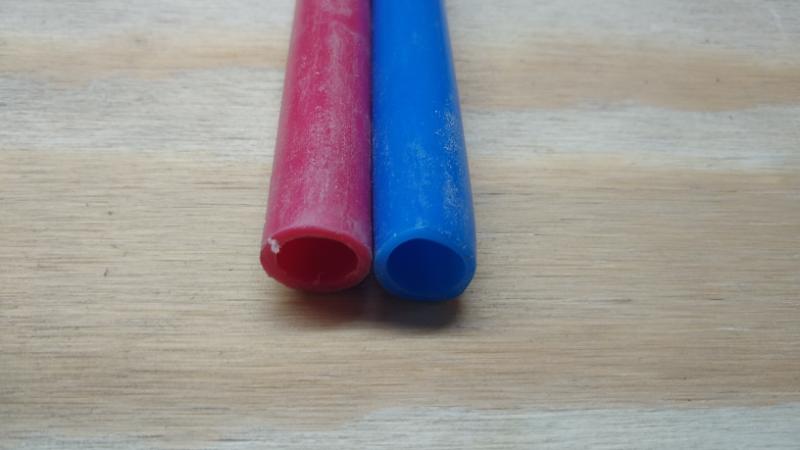
Most RV manufacturers use PEX tubing between the water pump and your fixtures. Some manufacturers will use a single color (often natural hazy white) throughout. Other manufacturers use red for hot, and blue (or white) for cold.
PEX FAQs At-A-Glance
What Is PEX?
Technically, PEX is a cross-linked polyethylene tubing, but you didn’t really care about that, did you? It’s just a semi-rigid pipe good for potable water use.
PEX is normally sold in a spool, not in straight lengths. A typical spool of ½” PEX holds about 1,200 feet.
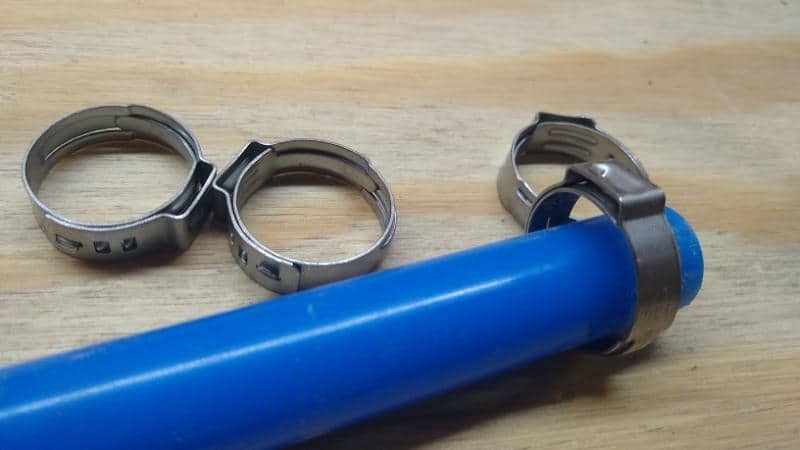
It’s kinda bendy, but you typically need elbows or corner channels if you want to turn the PEX 90 degrees in a small area. PEX has memory, so if you bend it, it’ll partially hold its shape.
Is RV Plumbing PEX?
Yes, it is! For the past 10-20 years, almost all RV manufacturers have used PEX tubing in their freshwater distribution systems. PEX was first introduced to the U.S. residential plumbing industry in the 1980s.
Below, you can see blue PEX for the RV cold water lines and braided vinyl hoses to the water pump.

Can You Use PEX in an RV?
Yes, you can! In fact, it’s become the de facto standard. In ye olde times, RV manufacturers used gray polybutylene tubing, but that’s gone extinct. And yes, you can substitute PEX for polybutylene tubing in a legacy system.
Most RVs use PEX B, what you can think of as “regular PEX.” Some manufacturers use PEX A, which is a more ductile version. PEX A can be used with expansion fittings instead of clamp fittings. If you have an RV plumbed with PEX A and expansion fittings, consider yourself lucky! That’s a smart way of doing things. But most manufacturers use PEX B, and that’s what this article will focus on.
Can You Use PEX for Hot Water?
Yes, you can! PEX is used for both hot and cold, potable and non-potable applications. In fact, there are all kinds of specialty applications for PEX, but we won’t get into those.
Some manufacturers will use a single color (often natural hazy white) throughout. Other manufacturers use red for hot, and blue (or white) for cold.
What Size Is the PEX Pipe In an RV?
When in doubt, you can always measure PEX yourself!
But since PEX is technically a pipe (measured by inside diameter) rather than a tube (measured by outside diameter), don’t expect the diameter of the pipe to match the trade size. ½” PEX, for instance, has an outside diameter of about 5/8″.
RV manufacturers generally use two PEX sizes: 1/2″ (most common) and sometimes 3/8″ (for branch lines).
In rare cases, you might see 3/4″ PEX for extremely long runs to reduce pressure drop. Most RV manufacturers use 1/2″ PEX everywhere, but some switch over to 3/8″ for branch lines. Cost savings, ya know.
What Kind of Fittings Should I Use for PEX Tubing?
You can use brass or plastic fittings. What you need are PEX barb fittings, which usually have a flared end and a series of flat ridges. Don’t confuse PEX fittings with hose barb fittings, which have similar-looking barbs.
Barb fittings are always paired with some kind of clamp. Stainless steel Oetiker ear clamps or copper clamp rings are the two most popular options. You need a special tool to use or disassemble either one.
There are many push-to-connect fittings available for use with PEX tubing: SharkBite, Flair-It, AquaLock, etc. I’ll save my comments on push-to-connect fittings for a different article. They are worth having in a pinch, but I wouldn’t plumb my entire RV with them.
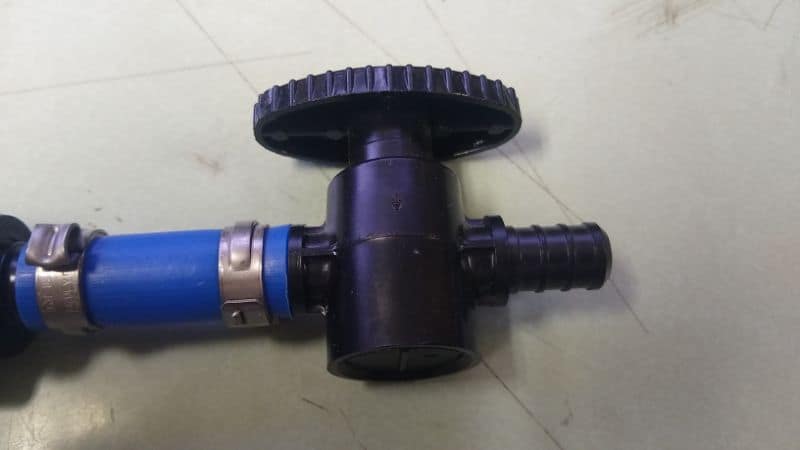
PRO TIP: Don’t confuse PEX barb fittings with hose barb fittings, which have conical rings.
How Do I Clamp PEX Tubing onto a Fitting?
If you’re using old-school crimp rings, you use a swaging tool; if you’re using a cinch clamp (also known as pinch clamp or Oetiker ear clamps), you use a different tool, shown below.
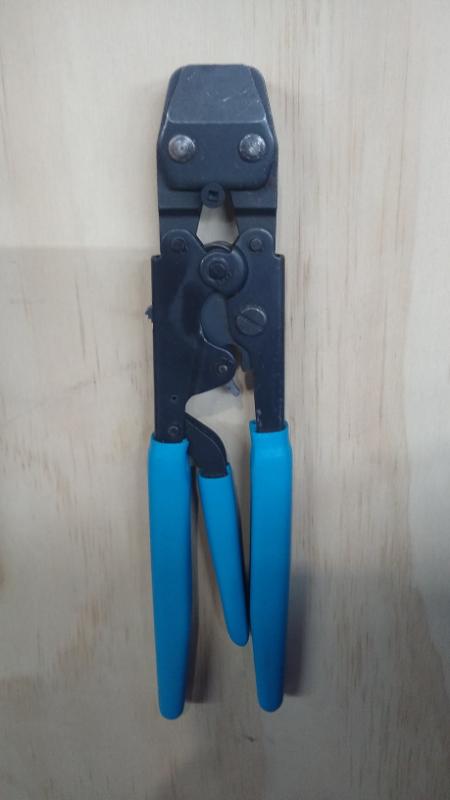
Don’t use hose clamps – they won’t give you even compression around the joint. You’re very likely to get leaks if you don’t use the right clamp! Hose clamps are for hack jobs. Use a cinch clamp!
Is RV PEX the Same as House PEX?
Yes, it is. The PEX used in an RV is “basic” PEX. It’s nothing special.
You might need special PEX for chlorinated recirculation systems or radiant floor heating, but good ol’ PEX from a Big Box store should work just fine for your RV.
Don’t get distracted by PEX A, PEX B, PEX C, PEX-AL-PEX. They all meet the same basic performance standards. They’re all the same size. When in doubt, go PEX B, as it’s the best combination of performance and price. PEX A best reserved when you’re using expansion fittings or working in very tight spaces.
Seriously. Any legitimate PEX (tested to ASTM F876 and ANSI 61) will do the job. Almost all PEX sold in the U.S. is tested to the same pressure and temperature standards:
- 200°F at 80 psi
- 180°F at 100 psi
- 74°F at 160 psi
Can I Use PEX Outside?
Not recommended. PEX isn’t truly UV-resistant. If you run it outside, you’ll need to protect it from sunlight and freezing.
Can PEX Freeze?
Hmmm. PEX itself is freeze-resistant, but it does become more brittle as the temperature drops. You should never allow water to freeze inside PEX! (Which is why you need to winterize your RV). Even though PEX can sometimes swell up to 3x its size without cracking, best not to test your luck!
Is PEX Tubing or Pipe?
This is a deep rabbit hole … but here goes!
PEX can be manufactured as tubing or pipe. But the pipe stuff is normally huge (at least 3.5” OD). For all practical purposes, all the PEX you’re likely to come across is a tube.
It’s tubing because the manufacturing process is controlled by the size of the outside diameter, not the inside diameter.
PEX is measured by its trade size, also known as the nominal size. This kinda-sorta-roughly corresponds to the inside diameter (ID). But not always.
- 1/2″ PEX tubing, for instance, has an OD of 0.625” and an ID of 0.485”. So the trade size is pretty close to the actual internal diameter.
- But 1” PEX tubing has an OD of 1.125” and an ID of 0.875.” Not even close!
PEX tubing is manufactured to Copper Tubing Size (CTS) standards, since PEX is usually substituted for copper in potable water systems. The tubing is then tested to ASTM F876 standards specification.
Here’s a table, courtesy of PEX universe, showing actual Inside Diameters and Outside diameters of PEX tubing, which is built to SDR pipe dimensions.
PEX Tubing Sizes
| PEX Tubing Size (CTS) | Outside Diameter (OD) | Inside Diameter (ID) | Min. Wall Thickness |
|---|---|---|---|
| 3/8 | 0.500 | 0.360 | 0.070 |
| 1/2 | 0.625 | 0.485 | 0.070 |
| 5/8 | 0.750 | 0.584 | 0.083 |
| 3/4 | 0.875 | 0.681 | 0.097 |
| 1 | 1.125 | 0.875 | 0.125 |
Head spinning yet?
I know, I know! Look, just don’t worry about it. Unless you go shopping in the dark cobwebs of the internet, you’ll have a hard time finding the wrong PEX.
What’s the Bend Radius of PEX?
Almost all commercial PEX sold in the U.S. has the same minimum bend radius:
- 3/8″ PEX: 4″ Bend Radius
- 1/2″ PEX: 5″ Bend Radius
- 5/8″ PEX: 6″ Bend Radius
- 3/4″ PEX: 7″ Bend Radius
- 1″ PEX: 9″ Bend Radius
As a rule of thumb, the minimum bend radius of PEX is approximately 8x its diameter.
A note on bend radius: If you over-bend PEX, it will kink, which will significantly block the water flow.
Can I Attach PEX to My RV Water Pump?
I want to call your attention to a common problem: Connecting your water pump directly to PEX pipe. Don’t do that. The PEX will carry vibrations from the water pump, and it’ll almost certainly hammer or thud or hum or make some obnoxious noise.
Instead, use high-pressure braided vinyl flex hoses to connect your RV on-demand water pump to the PEX manifold. You can source the hoses yourself or buy an OEM kit, like this one.

Can I Use [Insert Specialty Type] Of PEX?
Just don’t go shopping for weird PEX. Sure, you can buy reclaimed (non-virgin) PEX for non-potable water applications, certified PEX for radiant flooring applications, or special PEX for chlorinated water recirculation systems, but you have to work to find that stuff. For the most part, you could use “specialty” PEX inside an RV – it’s just not necessary.
If you’re not sure, read the 4-digit material designation code and check for ANSI/NSF ratings printed along the pipe length.
What’s a PEX Plumbing Trunk and Branch System?
Truck n’ branch systems have a main supply line with individual branches “tee’d” to each appliance.
IMHO, these are less optimal systems. They use less pipe, but they use lots of fittings and different pipe sizes. They are prone to pressure drop when multiple features are used. Appliances may have shut-off valves where they connect to the main trunk, which can be difficult to find!
What’s a PEX Plumbing Home Run Manifold System?
Hom erun systems route a single supply line from each fixture to a “home” manifold, connected directly to the water source. While this design uses more pipe, it reduces the number of fittings (and potential leak points), and reduces pressure drop potential to each fixture. All shut-off valves are at the manifold itself, making service and repair quite easy!
As you can tell, I have a soft spot for home run systems. These two systems can be combined in a Logic-style system, which uses several sub-manifolds rather a single “home” manifold.
Most (but not all) RVs use trunk n’ branch systems to save on material costs. If you can buy an RV with a home run manifold system, good for you!
There you have it! All your PEX questions answered! Well, maybe not all of them. If you have a real doozy, you can send me an email.
Truth is, the hardest thing about working with PEX in an RV is usually getting to it in the first place! But that’s for my next post …
Leave a Reply